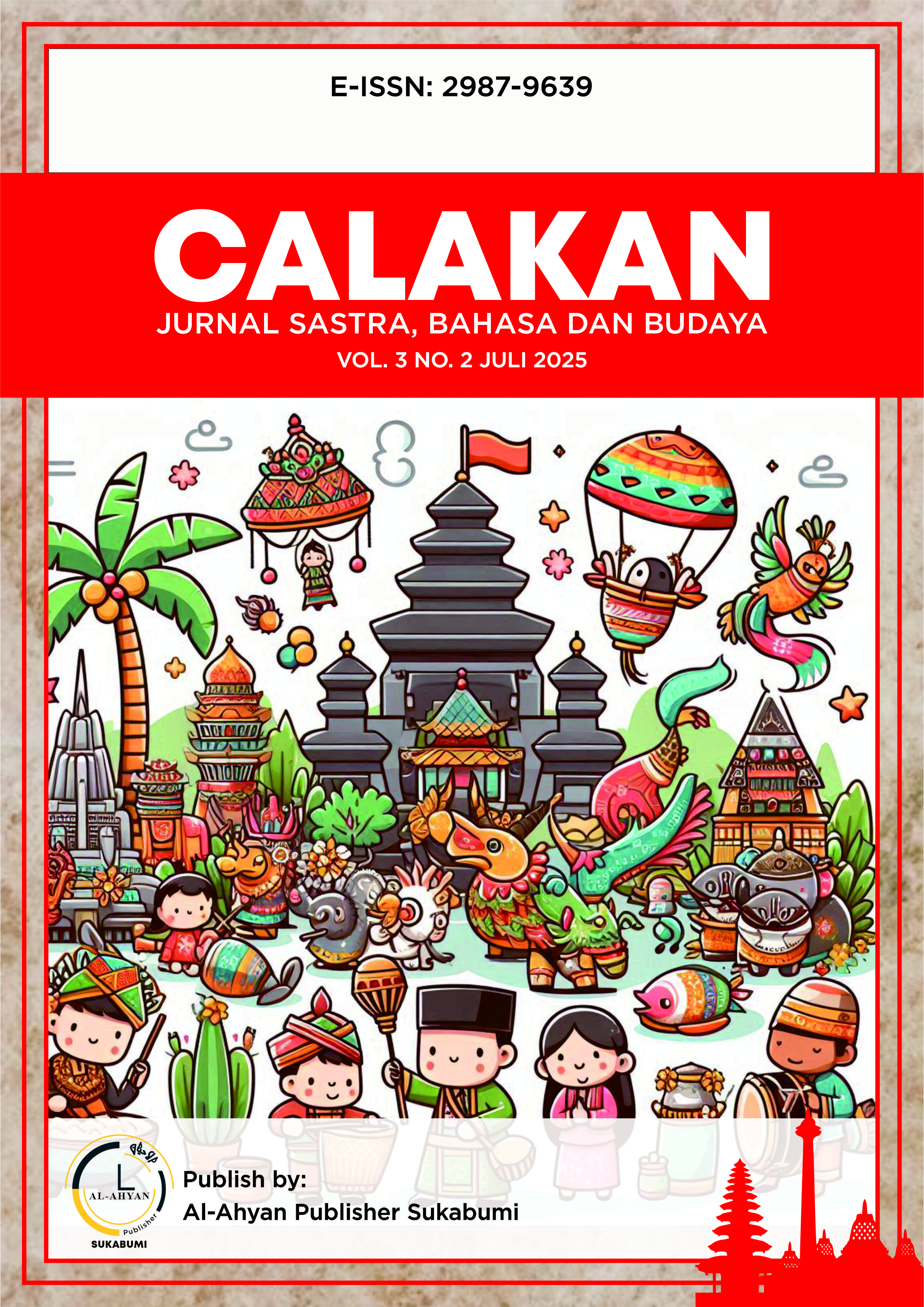The Manifestation Of Symbolic Violence In The Great Gatsby (2013): Pierre Bourdieu’s Perspective
DOI:
https://doi.org/10.61492/calakan.v3i2.372Keywords:
Symbolic violence, multimodal critical discourse analysis, The Great Gatsby, capital, Pierre Bourdieu, habitusAbstract
Symbolic violence is a gentle, imperceptible, and invisible violence that is often maintained by dominant groups through symbols, languages, cultures, and social norms. This study investigates the manifestation of symbolic violence in The Great Gatsby (2013) using Bourdieu’s theory of symbolic violence, focusing on concepts such as capital, habitus, field, and doxa. With a descriptive qualitative method and a multimodal critical discourse analysis approach, this study focuses on how symbolic violence is conveyed through various semiotic modes in the film, including verbal language, bodily gestures, visuals, and spatial arrangements. This study analyzes selected scenes that represent symbolic violence, focusing on six characters: Gatsby, Tom, Daisy, George, Myrtle, and Nick. The findings reveal that symbolic violence operates subtly through interactions shaped by social position and the unequal distribution of capital. Rather than being exercised by a single dominant character, symbolic violence emerges as a dynamic process where power shifts depending on who possesses dominant capital within specific social fields. These forms of symbolic violence are reinforced through the interplay of verbal, visual, gestural, and spatial elements of the film.
References
Allen, J. J., & Anderson, C. A. (2017). Aggression and Violence: Definitions and Distinctions. In The Wiley Handbook of Violence and Aggression (pp. 1–14). Wiley. https://doi.org/10.1002/9781119057574.whbva001
Al-Sabawy, M. R., Qassim, W. J., & Al-Sabawy, M. R. (2024). Psychological Violence and It is Relation to Academic Achievement of Middle School Students. http://www.pkheartjournal.com
Asimaki, A., & Koustourakis, G. (2014). Habitus: An Attempt at a Thorough Analysis of a Controversial Concept in Pierre Bourdieu’s Theory of Practice. Social Sciences, 3(4), 121. https://doi.org/10.11648/j.ss.20140304.13
Colaguori, C. (2010). Symbolic Violence and the Violation of Human Rights: Continuing the Sociological Critique of Domination. In International Journal of Criminology and Sociological Theory (Vol. 3, Issue 2).
Dinanti, P. D. & Nabillah, D. A. (2024). Animation in social transformation: Representation of environmental destruction and humanistic solution for solar technology in Scarygirl (2023). Dinasti International Journal of Education Management and Social Sciences 6(1): 399 - 408. https://doi.org/10.38035/dijemss.v6i1
Fatahillah, M. N. (2019). Representation of Social Issues in Siti and Turah Movie: A Study of Pierre Bourdieu’s Social Practice and Symbolic Violence [Universitas Brawijaya]. https://repository.ub.ac.id/id/eprint/175402/1/Muhammad%20Nif%E2%80%99an%20Fatahillah.pdf
Huang Xiaowei. (2019). Understanding Bourdieu - Cultural Capital and Habitus. Review of European Studies, 11(3), 45. https://doi.org/10.5539/res.v11n3p45
Linda, J. (2024). Identifying Symbolic Violence in the Comic Version of “Cinderella.” Lingua Susastra, 5(2), 131–141. https://doi.org/10.24036/ls.v5i2.294
Mayr, A. (2017). 1. Multimodal Critical Discourse Analysis (MCDA) (N.-M. K. Klung & Hartmut Stockl, Eds.; Vol. 7). De Gruyter. http://www.degruyter.com/view/product/185175?rskey=Qgk1a6&result=1
Muljadi, H., & Angjaya, S. (2024). BEAUTY STANDARDS AS SYMBOLIC VIOLENCE AGAINST WOMEN IN IMPERFECT: KARIER, CINTA, & TIMBANGAN (2019). Paradigma: Jurnal Kajian Budaya, 14(3), 435–450. https://doi.org/10.17510/paradigma.v14i3.1520
Noviani, R. (2018). Wacana Multimodal Menurut Gunther Kress dan Theo Van Leeuwen. https://www.researchgate.net/publication/341755008_Wacana_Multimodal_Menurut_Gunther_Kress_dan_Theo_Van_Leeuwen
Pezotta, E. (2010). Film_Analysis_A_Comparison_among_Critici. 1(2). https://widescreenjournal.org/wp-content/uploads/2021/06/film-analysis-a-comparison-among-criticism-interpretation-analysis-and-close-analysis.pdf
Putri, C. A. (2020). Symbolic Violence among Characters in Selected Eka Kurniawan's Works. Indonesian Journal of English Language Studies (IJELS), 6(1), 35–48. https://doi.org/10.24071/ijels.v6i1.2694
Rahayu, M., Mediyansyah, M., & Hajar, S. (2022, August 5). Symbolic Violence among Young Urban People Represented in the Short Stories “Wabah.” https://doi.org/10.4108/eai.9-10-2021.2319675
Sekartaji, M., Dinanti, P.A. & Damanik, F. Y. (2023). People habitus and sustainability through reading literature after the COVID-19 pandemic. Transdisciplinary Symposium on Business, Economics, and Communication 2022. KNE Publishing https://doi.org/10.18502/kss.v8i12.13681
Taha, K., Maani, H., Al Dwakiat, K., & Abu-Tayeh, K. (2023). An Analysis of Bourdieu’s Habitus and Field Theory in Hamid’s The Reluctant Fundamentalist. Theory and Practice in Language Studies, 13(1), 161–167. https://doi.org/10.17507/tpls.1301.18
Thapar-Björkert, S., Samelius, L., & Sanghera, G. S. (2016). Exploring symbolic violence in the everyday: Misrecognition, condescension, consent and complicity. Feminist Review, 112(1), 144–162. https://doi.org/10.1057/fr.2015.53
Downloads
Published
How to Cite
Issue
Section
License
Copyright (c) 2025 Mensiana Tamo, Todo Sibuea

This work is licensed under a Creative Commons Attribution-ShareAlike 4.0 International License.










